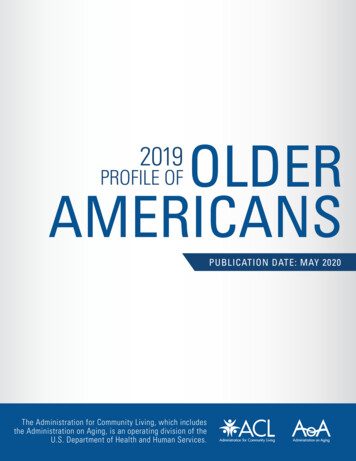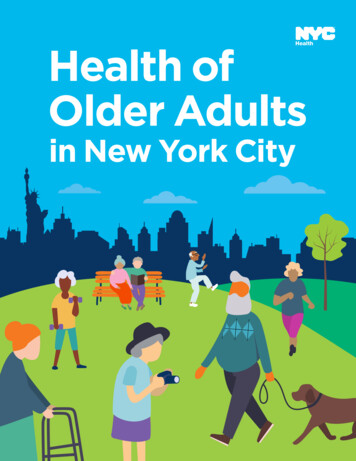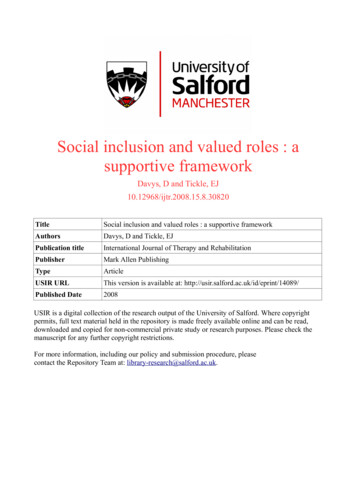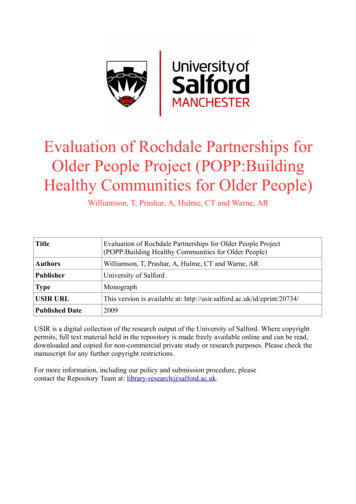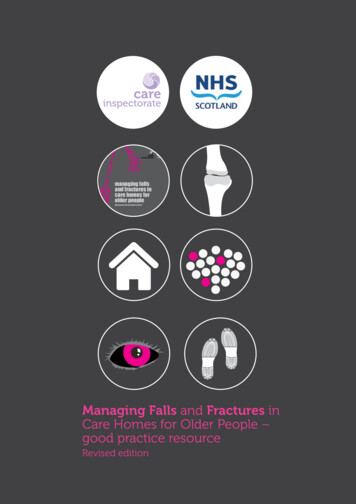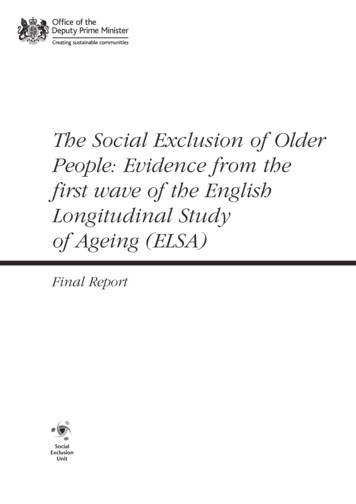
Transcription
The Social Exclusion of OlderPeople: Evidence from thefirst wave of the EnglishLongitudinal Studyof Ageing (ELSA)Final Report
The Social Exclusion of OlderPeople: Evidence from thefirst wave of the EnglishLongitudinal Studyof Ageing (ELSA)Final ReportJanuary 2006Prepared for the Office of the Deputy Prime MinisterBy Matt Barnes, Annelies Blom, Kate Cox and Carli Lessof,National Centre for Social Research, and, Alan Walker, University of Sheffield
The findings and recommendations in this reportare those of the consultant authors and do notnecessarily represent the views or proposedpolicies of the Office of the Deputy Prime MinisterOffice of the Deputy Prime MinisterEland HouseBressenden PlaceLondon SW1E 5DUTelephone: 020 7944 4400Web site: www.odpm.gov.uk Queen’s Printer and Controller of Her Majesty’s Stationery Office, 2006Copyright in the typographical arrangement rests with the Crown.This publication, excluding logos, may be reproduced free of charge in any format or medium forresearch, private study or for internal circulation within an organisation. This is subject to it beingreproduced accurately and not used in a misleading context. The material must be acknowledged asCrown copyright and the title of the publication specified.For any other use of this material, please write to HMSO Licensing, St Clements House,2-16 Colegate, Norwich NR3 1BQ. Fax: 01603 723000 or e-mail: licensing@hmso.gov.uk.January 2006Product Code 05 ASD 03609
ContentsABOUT THE AUTHORS5ACKNOWLEDGEMENTS6EXECUTIVE SUMMARY712INTRODUCTION111.1Aims111.2What is social exclusion and how can it be measured?111.3Using the English Longitudinal Survey of Ageing to measure social exclusion121.4A profile of older people13MEASURING SOCIAL EXCLUSION AMONG OLDER PEOPLE152.1Identifying the dimensions of social exclusion152.1.1 Social relationships162.1.2 Cultural activities162.1.3 Civic activities162.1.4 Access to basic services162.1.5 Neighbourhood exclusion172.1.6 Financial products172.1.7 Material goods17Defining exclusion on each dimension172.23INVESTIGATING THE DIFFERENT DIMENSIONS OF EXCLUSIONAMONG OLDER PEOPLE203.1Characteristics of excluded older people203.1.1 Age203.1.2 Gender213.1.3 Ethnicity223.1.4 Living arrangements and other family members233.1.5 Main activity status253.1.6 Health263.1.7 Income and wealth293.1.8 Residence303.1.9 Means of communication and travel32Risk factors for the separate dimensions of exclusion363.2
The Social Exclusion of Older People: Evidence from the first wave of the English Longitudinal Study of Ageing (ELSA)45INVESTIGATING MULTIPLE EXCLUSION AMONG OLDER PEOPLE404.1Identifying multiple exclusion404.2Patterns of multi-dimensional exclusion414.3Risk factors for multiple exclusion514.4Exclusion and quality of life53SUMMARY OF MAIN FINDINGS AND POLICY DIRECTIONS575.1The social exclusion of older people: the evidence from ELSA575.2Policy directions59REFERENCES61APPENDICES63ACONSTRUCTING DIMENSIONS OF EXCLUSION64Exclusion from social relationships64Exclusion from cultural activities70Exclusion from civic activities72Exclusion from access to basic services74Neighbourhood exclusion77Exclusion from financial products80Exclusion from common consumer goods83EXPLORING RISK FACTORS FOR THE DIFFERENT DIMENSIONSOF EXCLUSION86BCEXPLORING RISK FACTORS FOR MULTIPLE EXCLUSION110
ABOUT THE AUTHORSMatt Barnes is a Research Director at the National Centre for Social Research. He joined NatCenhaving completed a Ph.D. on social exclusion at the University of Bath. His main researchinterests are the measurement of poverty and social exclusion, and issues of work-life balance.At the time this report was being prepared, Annelies Blom was a researcher at the NationalCentre for Social Research. She is now working at ZUMA and is studying for a PhD atMannheim University.Kate Cox is a senior researcher in the Longitudinal Studies Group at the National Centre forSocial Research. She is a key member of the ELSA research team. Before joining NatCen shecarried out research on communication between patients and health care professionals aboutmedicines at King’s College London.Carli Lessof is the head of the Longitudinal Studies Group at the National Centre for SocialResearch which is responsible for delivering the 2004 surveys of the National ChildDevelopment Study, the 1970 Birth Cohort Study, the third and fourth sweeps of theMillennium Cohort Study and designs and implements the English Longitudinal Study ofAgeing. Carli is a co-investigator of ELSA.Alan Walker has been Professor of Social Policy at the University of Sheffield since 1985. Hismain research fields are social care, social gerontology and European social policy. He hasconducted many studies within the EU about social exclusion and social integration, especiallyamong older citizens.5
ACKNOWLEDGEMENTSWe are grateful to the Office for the Deputy Prime Minister, the Department for Work andPensions and the New Horizons Programme for funding this project, and to the policy makers,academics and key players in the field of ageing policy and research who gave their time todebate the issues presented in this report at the seminar held on 2nd December 2005. As withall research of this kind, we are entirely dependent on the good will of all those people whogive up their time to provide information about their lives and we are very grateful to them.Although this report was commissioned by the Office, the findings and recommendations arethose of the authors and DO NOT necessarily represent the views of the Office of the DeputyPrime Minister. This report will form part of our evidence base when tackling future issuesand policies.6
EXECUTIVE SUMMARYThis report presents the results of an innovative study about the social exclusion of olderpeople. The study of exclusion experienced by older people is relatively new. In the past, mostresearch has focussed on exclusion experienced by people of working age or by families withchildren.The study was carried out by the National Centre for Social Research and Professor Alan Walkerfrom the University of Sheffield. It uses 2002-3 data from the English Longitudinal Study ofAgeing (ELSA) which is a large-scale survey of people aged 50 and over living in England.The broad aim of the study was to see whether insights about social exclusion could be drawnfrom this relatively new data source in a way that might strengthen existing knowledge aboutthe particular experiences of exclusion among older people. The main objective of this shortproject was to measure the patterns of different forms of social exclusion among older peopleand to examine the key risk factors, or indicators, of social exclusion among older people.The main report presents the results of this analysis and some interpretations. Key findings aresummarised below.How was social exclusion measured?Social exclusion is multi-dimensional and, in this study, seven dimensions are constructed fromthe ELSA data: social relationships (contact with family and friends), cultural and leisure activities (for example going to cinema or theatre), civic activities (for example membership of a local interest group, voluntary work, voting), basic services (for example health services, shops), neighbourhood (for example safety and friendliness of local people), financial products (for example bank account, pension), material goods (for example consumer durables, central heating).The concept of “multiple exclusion” was applied when people were excluded on three or moreof these dimensions.What are the main findings?Around half of older people are not excluded on any of the dimensions but. 29% are excluded on one dimension, 13% on two dimensions, and 7% on three or more dimensions.7
The Social Exclusion of Older People: Evidence from the first wave of the English Longitudinal Study of Ageing (ELSA)What are the main risk factors for multipleexclusion amongst older people?There are seven key characteristics that are most strongly related to an older personexperiencing multiple exclusion: age: being 80 and over, family type: living alone, having no living children, health: poor mental or physical health, mobility: no access to private car and never uses public transport, housing tenure: rented accommodation, income: low income, benefits as the main source of income, telephone: those without access to a telephone.Being unemployed, living in a city and undertaking no physical exercise were also related tomultiple exclusion but less strongly so than the characteristics above.The study also revealed some connections between the different forms of exclusion but therewas no simple domino effect where exclusion in one area appears to link to exclusion inanother and so on. There are two sets of circular connections: social relationships, civicactivities and neighbourhood exclusion; and civic activities, financial products and materialgoods. Not surprisingly the strongest interconnections are between exclusion in the areas ofmaterial goods and financial products, and between exclusion from cultural activities and basicservices. The report did not look in detail at these associations and hence further work in thisarea could investigate whether particular groups of older people experience distinctly differentforms of multiple exclusion.The release of the second wave of ELSA data in late 2005 will allow an analysis and betterunderstanding of how social exclusion develops and whether it is briefly felt or long lasting.This may provide important insights into the experiences of exclusion, in those aged 50and over.Were the risk factors the same for eachdimension?No. While there are some characteristics that increase the chances of exclusion across severaldimensions, there are none that span all of them. There are some that are particularly stronglyrelated to one of them.The factors with the widest influence over the dimensions are: 8depression (6 dimensions, not material goods),
The Social Exclusion of Older People: Evidence from the first wave of the English Longitudinal Study of Ageing (ELSA) poor health (related to 5 dimensions: not civic activities and financial products), living alone (related to 4 dimensions: basic services, material goods, social relationshipsand civic activities), membership of a non-white ethnic group (related to 4 dimensions: cultural activities, civicactivities, financial products and material goods), renting accommodation (related to 4 dimensions: civic activities, neighbourhood, financialproducts and material goods), not having access to a private car or van (related to 4 dimensions: social relationships,cultural activities, basic services and material goods), low income (related to 3 dimensions: financial products, material goods and culturalactivities), being female (related to 3 dimensions: cultural activities, civic activities and financialproducts).Age itself is not strongly connected to every dimension. It is a risk factor for the older-old withregard to exclusion from basic services and material goods and, for the younger-old, withregard to civic activities.The factors that are closely related to a single dimension of exclusion are: Social relationships: being male, living alone, having no partner or children. Cultural activities: having poor health and feeling depressed. Civic activities: never using public transport, having a low education and feelingdepressed. Basic services: being older, having poor health, lacking access to transport (public orprivate) and living alone. Neighbourhood: having poor health and living in a deprived area. Financial products: having low income, relying on benefits or self-employment as themain source of income and renting accommodation. Material goods: living alone, having no children, being without a telephone and access toa car or van and renting accommodation.What is the impact of social exclusion on qualityof life?Not surprisingly, there appears to be a connection between multiple exclusion and the qualityof life/well-being of older people. Overall quality of life falls as the number of dimensionsolder people are excluded on increases. The aspects of quality of life defined in terms of self-9
The Social Exclusion of Older People: Evidence from the first wave of the English Longitudinal Study of Ageing (ELSA)realisation (optimism, life satisfaction, disposition, energy) appear to be most related to multipleexclusion. Multiply excluded older people are also likely to report a lack of control over theirlives. This was not the main focus of the study, so it was only possible to look briefly at therelationship between social exclusion and quality of life. As such the findings are notconclusive but they do suggest that future analysis would be worthwhile.Which policy areas should be targeted?The possible policy implications of our findings will be elaborated in a separate report that isdue to be published in Autumn 2006, nevertheless there are some key issues to which weshould draw attention. For example, the report identifies that 7 per cent of older people arecurrently experiencing multiple exclusion and this group seems sensibly to be the focus ofpolicy action. Our findings suggest six targets for policy action. These are people with physicaland mental health problems; problems of place (living alone and living in the social rentedsector); problems with transport; the particular experiences of the oldest old; those living onlower incomes and those over 50 but under pension age who are unemployed. As well asnational policies with regard to employment of the over 50s and incomes in older age, thereport suggests the need for co-ordinated actions at the local level in order to target the mostvulnerable. It is suggested that local strategies, focussed explicitly on addressing the problemsfaced by the multiply excluded, should unite local government, NHS providers, the voluntarysector and private sector providers.10
CHAPTER 1Introduction1.1 AimsIn the summer of 2005, the Office of the Deputy Prime Minister commissioned the NationalCentre for Social Research and Professor Alan Walker from the University of Sheffield, toanalyse data from the English Longitudinal Study of Ageing (ELSA). The aim was to seewhether insights about social exclusion could be drawn from this relatively new data source ina way that might strengthen existing knowledge about the particular experiences of exclusionamong older people.Specifically, the aim of this short project was to: measure the patterns of different forms of social exclusion among older people, and to examine the key risk factors of social exclusion among older people.This report presents initial findings from the analysis and provides some interpretations.A second element of the project was to discuss these findings with key stakeholders –including academics and policy specialists – to explore the implications that the findings mighthave for future policy. Who, for example, are the groups most likely to be socially excluded in2010 or 2020? And how might social exclusion among older people be countered in the future?The deliberations from these discussions will be presented in a separate report (Walker et al,forthcoming 2006).1.2 What is social exclusion and how can it bemeasured?Social exclusion is commonly used to refer to the process that leads to a breakdown of therelationship between society and the individual (Room, 1998). It is a dynamic process, whichprevents access to different elements of the social, economic, political or cultural componentsof everyday life and is usually contrasted with static concepts of poverty (Walker and Walker,1997). There is an emerging national and international literature which explores how we shouldmeasure this difficult concept (Barnes, 2005; Berthoud, 2003; Barnes et al, 2002; Burchardt et al,1999; Lessof and Jowell, 1999). Nolan and Whelan (1996) were among the first to emphasisethe importance of identifying different dimensions of disadvantage, and the relationshipbetween them, in order to thoroughly understand social exclusion. Since then, various attemptshave been made to measure the prevalence and risk factors of social exclusion using surveydata (see studies referred to above).11
The Social Exclusion of Older People: Evidence from the first wave of the English Longitudinal Study of Ageing (ELSA)The Social Exclusion Unit offers one of the clearest explanations of what social exclusion is,and how it might be measured. It is “.what can happen when people or areas suffer from acombination of linked problems such as unemployment, poor skills, low incomes, poorhousing, high crime environments, bad health and family breakdown” (SEU, 2000, emphasisadded). Exploring these multiple dimensions of social exclusion among older people is oneof the key aims of this report.To date, our understanding of the complex structure of social exclusion among older peoplehas been limited, with most research focussing on social exclusion amongst the generalpopulation. The ESRC Growing Older Programme provided the first reliable information aboutsocial exclusion in deprived neighbourhoods and among ethnic minorities (Scharf et al 2004;Nazroo et al 2004). The Social Exclusion Unit’s ‘Excluded older people’ programme is breakingnew ground in this area (Phillipson and Scharf, 2004). Other research has been more limitedin its scope but has gradually developed our understanding of different aspects of socialexclusion, for example finding that retired people on low income are less likely to belong toa club or social organisation than their counterparts with higher incomes (Middleton, 2002;Adelman and Cebulla, 2002). A great deal is still to be learnt.1.3 Using the English Longitudinal Surveyof Ageing to measure social exclusionThe English Longitudinal Study of Ageing (ELSA) provides a rich new data source with whichto examine social exclusion and its drivers over time. This section provides some backgroundto the study.ELSA is funded by the National Institute on Ageing and a consortium of UK governmentdepartments led by the Office for National Statistics. It is designed and carried out througha collaboration between University College London, the Institute for Fiscal Studies and theNational Centre for Social Research.The ELSA sample was originally drawn from households who responded to the Health Surveyfor England (HSE) in 1998, 1999 or 20011. Individuals were considered eligible to be coremembers of ELSA if they had been living in an HSE household, were 50 or over and were stillliving in a private residential address in England2.The first ELSA survey was carried out in 2002-3. It is considered the ‘baseline’ study and isreferred to as wave 1. ELSA is a longitudinal study and the design strategy is to collect dataevery two years. The second ELSA survey took place in 2004-5, and interviewers went back toas many wave 1 respondents as possible. Data from wave 2 will be available from the DataArchive in early 2006 and fieldwork for wave 3 will begin in Spring 2006. This longitudinaldesign means that ELSA will aid understanding of how and why people’s lives change as theygrow older. As a result it will become possible to look at experiences of social exclusion overtime and to explore its dynamic nature.Great efforts were made to ensure that fieldwork for wave 1 of ELSA was successful, includinga thorough strategy for tracing and contacting eligible individuals who had moved since the1As well as providing a good sampling frame this also means that there is a great deal of information about eachrespondents health status even before they took part in ELSA.2Details about eligibility can be found in the ELSA report (Marmot et al, 2003)12
The Social Exclusion of Older People: Evidence from the first wave of the English Longitudinal Study of Ageing (ELSA)HSE interview. The wave 1 survey achieved a household response rate of 70 per cent, and 96per cent of eligible individuals in these households agreed to take part. This meant thatapproximately 12,000 older people took part in the survey.The analysis in this report is based on wave 1 information only. A number of respondents’information was not included in this analysis for a variety of reasons: 636 respondents were not included in the analysis because they were partners of ELSAcore members who were too young to be eligible for the study in their own right; 72 respondents were not included in the analysis because they moved into the householdafter the HSE interview took place; 158 respondents were not included in the analysis because they were interviewed byproxy because they were physically or mentally unable to take part personally; 204 respondents were not included in the analysis because their face-to-face interviewwas not complete.Furthermore, this analysis relied on answers to specific questions that were used to constructthe seven dimension of exclusion. In practice this meant that: 215 respondents were not included in the analysis because they did not return theself-completion questionnaire which contained many of the questions that are relevantto social exclusion; a further 422 respondents were not included in the analysis because they did not respondto particular questions that were used to construct the seven dimension of exclusion.In total, the analysis in this report uses the 9,901 core ELSA members who took part in personand completed both a face-to-face interview and a self-completion questionnaire (and were notexcluded from the analysis for any of the other reasons given above). The remaining samplesize is far larger than is available from other surveys because of the focus of ELSA on olderpeople and the analysis in this report uses weights that account for non-response.One of the great strengths of ELSA is that it covers a very wide range of topics includingindividual and household characteristics; physical, cognitive, mental and psychological health;housing, work, pensions, income and assets; expectations for the future; social participationand social support. This diversity is invaluable here, as examining the relationship betweensocial exclusion and a wide range of other factors is key to the investigations in this study.1.4 A profile of older peopleThis section describes some of the basic social, demographic and economic characteristics ofolder people (defined in this report as people aged 50 years and over, the target sample ofELSA). It is important to understand these characteristics as they help us remember how diversethe population of older people is and how many older people fall into different sub-groups.Indeed, these are the characteristics that we will use to explore what might drive socialexclusion later in the report. Understanding the profile of older people also matters whendeciding how to prioritise policies that might affect different groups. For example, factors thatseem to drive social exclusion and affect large groups might be given a particular policy13
The Social Exclusion of Older People: Evidence from the first wave of the English Longitudinal Study of Ageing (ELSA)priority. Alternatively, those that have a very significant effect on a distinct minority in thepopulation may need to be given particular focus. Appendix A provides a series of detailedtables where more information can be found3.The socio-demographic and economic characteristics of the population of older people arediverse, and a detailed description can be found in Marmot et al (2003). Some of the mainconclusions are summarised below.There are more women than men in the older population, a consequence of the higher survivalrate of women than of men. The proportion of older people living with a partner is smallcompared with the proportion for younger people. As age increases, so does the likelihoodof widowhood, and simultaneously there is a fall in the likelihood of living with a spouse orpartner and in the average number of people who live in a household. These are veryimportant factors in determining health, mortality and a number of other aspects in the qualityof life of older people.Over three-quarters of the ELSA population live in households without children. A relativelysmall proportion reported living with children in the household and there was a clear agegradient in the proportion of people who had two or three children, with this proportiondecreasing with age.Kinship relationships are likely to be important to older people because of their effects onmortality and well being. Over three-quarters of ELSA respondents reported having at least oneliving sibling. There were some age differences in the number of siblings, with the proportionsof people who report having living siblings declining with age.Marmot et al (2003) found that marital status differed by educational attainment of therespondent and so did cohabitation with a partner. People with a higher level of educationwere more likely either to be married or to be living with a partner. The number of childrenvaried with educational attainment for women but not for men. The mean number of childrenper woman was lower for those with a degree or other higher educational qualification thanfor those with no qualifications. A similar pattern was found when analyses were carried out byoccupational classification.Comparing the youngest-old (people aged 50 to 59 years) with the oldest-old (people aged 80years and above) reveals that the younger age group is particularly likely to live with theirpartner and children, to be employed, have better physical and mental health, have lessmobility problems, a higher income and more likely to have access to a car or van. Converselythe older age groups are more likely to live alone, to not be working, have a worse physicaland mental health, more mobility problems, to have had a fall in the past two years, have alower income and to lack access to a car or van.These findings provide an important starting point for analyses of social exclusion among olderpeople using the ELSA data.314In addition, this indicates the size of different sub-sets of the sample - the larger the group of people interviewedthe more likely we are to have meaningful results to report.
CHAPTER 2Measuring Social ExclusionAmong Older PeopleIn this chapter the rationale for choosing seven different dimensions of social exclusion isexplained, as are the details of how each was constructed using information collected for ELSA.The majority of the chapter explores the experience of the different forms of exclusion forvarious socio-demographic and economic characteristics of older people and looks at thecharacteristics that are significantly related to exclusion when taking other, potentiallyconfounding characteristics into account.2.1 Identifying the dimensions of social exclusionIn order to understand social exclusion and how it affects older people, we first need toidentify the different dimensions of disadvantage that it is comprised of, and decide how theycan be measured using data from ELSA. It is important to remember that ELSA was notdesigned specifically to measure social exclusion though, because of its multi-disciplinarynature, a number of questions that relate to social exclusion were included in thequestionnaire. Since there is no universally agreed way to measure social exclusion, the choiceof dimensions used in this study has been guided by the theoretical literature on socialexclusion of older people and by current policy interests. These dimensions have beenamended and built on as appropriate, taking the opportunities and constraints of the ELSAsurvey into account. The seven dimensions of exclusion that we use for this research are:1.Exclusion from social relationships2.Exclusion from cultural activities3.Exclusion from civic activities4.Exclusion from access to basic services5.Neighbourhood exclusion6.Exclusion from financial products7.Exclusion from material goodsThis list is not definitive. There are other aspects of older people’s lives that might beconsidered to be evidence that someone is experiencing social exclusion. For the purpose ofthis study various decisions have been made. For example, having poor health (either physicalor mental) is not considered to be a measure of exclusion. There may be instances where poorhealth can be perceived as an outcome of social exclusion, for example where isolation andlow income contribute to poor mental health, but in this study poor health is considered as a15
The Social Exclusion of Older People: Evidence from the first wave of the English Longitudinal Study of Ageing (ELSA)risk factor of social exclusion. Considering the health of older people in this way means thestudy can investigate how different degrees of health are related to the seven dimensions ofexclusion listed above and, from a policy perspective, how changes in health status are relatedto the experiences of older people (for example how poor health might be related to anincrease in the experience of exclusion).The conceptual meaning of each of the seven dimensions of exclusion is outlined below.Greater detail about each dimension is provided in Appendix B.2.1.1 SOCIAL RELATIONSHIPSThe social relationships dimension tries to capture the frequency of contact with family andfriends and the density of these relationships. It explores close social bonds within thehousehold through relationships with any partners and children who live there. So as not tobias against people that live alone, special consideration is given to relationships outside of thehousehold, either in person or by telephone, with children, other immediate family or friends.2.1.2 CULTURAL ACTIVITIESThe cultural activities dimension tries to capture the notion of exclusion from cultural activitiesfor which people have to leave the home. Activities considered include going to the cinema,visiting an art gallery or museum and going to the theatre, concert or opera. This
Basic services: being older, having poor health, lacking access to transport (public or private) and living alone. Neighbourhood: having poor health and living in a deprived area. Financial products: having low income, relying on benefits or self-employment as the main source of income and renting accommodation.



